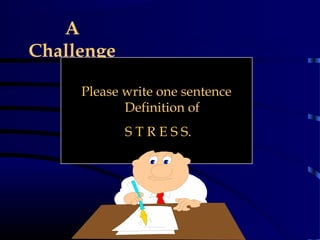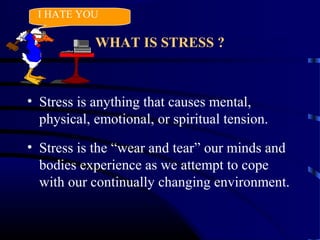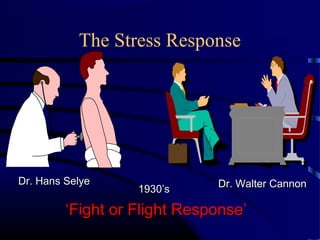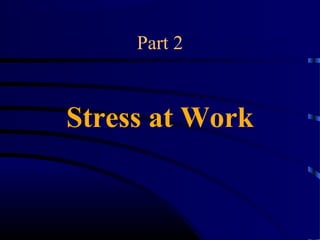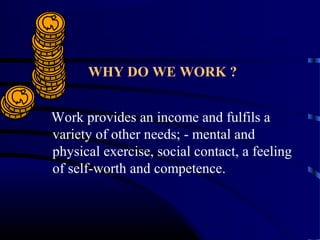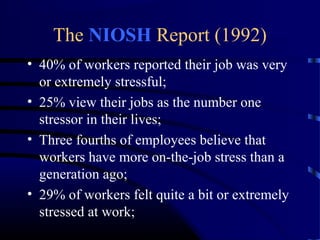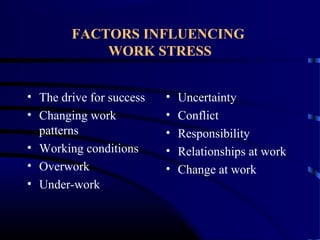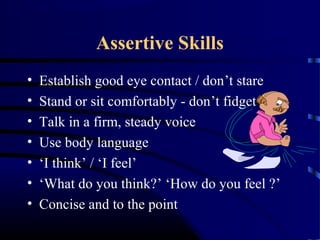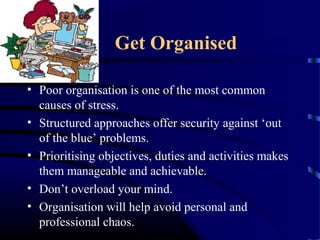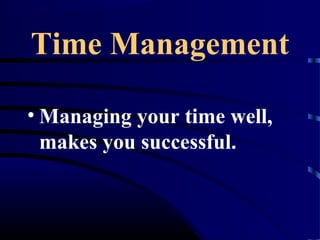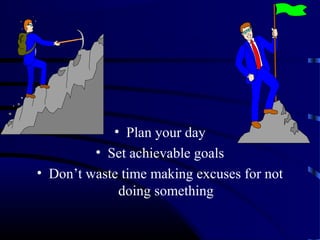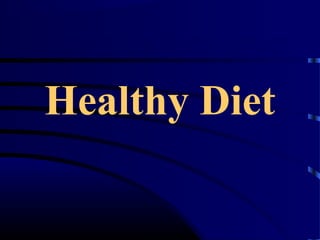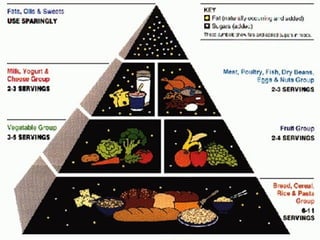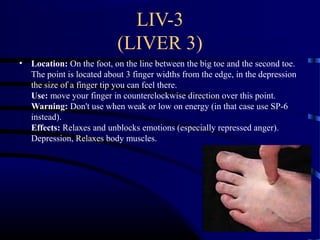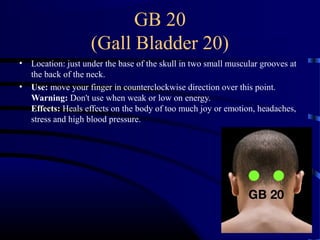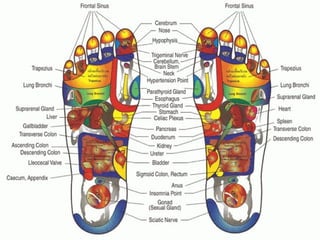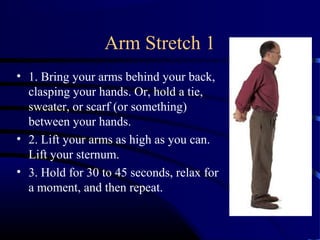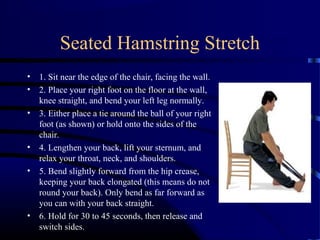Smart program
- 1. ”Learn how to combine ancient wisdom with a scientific, practical, individualized approach to be healthy and happy – and achieve true wellness.”
- 2. Stress Management & Relaxation Training (SMART) Program with Health Preservation, Personality Development & Anti-aging By, Dr. Shahzad Anwar Tirmzi INSTITUTE OF STRESS MANAGEMENT & PERSONALITY DEVELOPMENT 16 AWAISIA SOCIETY COLLEGE ROAD TOWNSHIP, LAHORE Ph: 0345 8477000 0423 5184139 E-mail: ismpd.pk@gmail.com www.ismpd.com
- 3. Presentation Outline Part 1 - General Awareness Part 2 - Stress at Work Part 3 – Coping Strategies
- 4. Part 4 – Relaxation Techniques Part 5 – Health Preservation & Anti- aging Part 6 – Acupressure, Reflexology, Yoga
- 5. Objectives of the Program • Understanding Stress • Coping Strategies • Relaxation Techniques • Self awareness – Confidence • Behavior – Choice and Decision • Positive thinking - Values • Spirituality – Beyond Human
- 7. A Challenge Please write one sentence Definition of S T R E S S.
- 8. WHAT IS STRESS ? • Stress is anything that causes mental, physical, emotional, or spiritual tension. • Stress is the “wear and tear” our minds and bodies experience as we attempt to cope with our continually changing environment. I HATE YOU
- 9. WHAT IS STRESS ? • Simply put, stress is any outside force or event that has an effect on our body or mind. Stress is life. It arises when we worry that we can’t cope. HELP ME!
- 10. S = P > RStress occurs when the pressure is greater than the resource
- 11. ‘Stress is a socially acceptable form of mental illness’
- 12. TYPES OF STRESS
- 13. NOT ALL THE STRESS, WE EXPERIENCE IS NEGATIVE
- 14. EUSTRESS Eustress or positive stress occurs when the level of stress is high enough to motivate you to move into action to get things accomplished.
- 15. DISTRESS Distress or negative stress occurs when the level of stress is either too high or too low and your body and/or mind begin to respond negatively to the stressors.
- 18. The Stress Response 19301930’’ss Dr. Hans SelyeDr. Hans Selye Dr. Walter CannonDr. Walter Cannon ‘‘Fight or Flight ResponseFight or Flight Response’’
- 19. Endocrine System Stress response is controlled by the Endocrine System. Sympathetic Parasympathetic
- 20. • Increased or excessive demands on the physical or mental systems of the body result in increased sympathetic activity and hormone secretion (Adrenaline, Testosterone)
- 21. SYMPTOMS OF STRESS • Physical symptoms • Mental symptoms • Behavioural symptoms • Emotional symptoms
- 22. When you are stressed, it may result in any or all of the following: • Decrease in communication. • Decrease in motivation. • Decrease in performance. • Learned helplessness.
- 23. • According to Wikipedia, “learned helplessness is a psychological condition in which a person feels that he/she has no control over his/her situation and that whatever he/she does is futile. • As a result, he/she will stay passive when the situation is unpleasant or harmful.”
- 24. STRESS RELATED ILLNESSES Stress is not the same as ill-health, but has been related to such illnesses as; • Cardiovascular diseases • Immune system diseases • Asthma • Diabetes
- 25. • Modern medical science proves that more than 95% of diseases result from chronic stress.
- 26. COSTS OF STRESS • In the UK, 40 million working days per year are lost directly from stress - related illness. Costs in absenteeism to British economy are estimated at £ 4.5 billion pounds per year.
- 27. Part 2 Stress at Work
- 28. WHY DO WE WORK ? Work provides an income and fulfils a variety of other needs; - mental and physical exercise, social contact, a feeling of self-worth and competence.
- 29. Stress is an integral and inevitable feature of most contemporary workplaces
- 30. Workplace stress arises when individuals perceive an imbalance between the pressures and demands made on them and the resources they have to cope with these demands
- 31. Job Stress Statistics Reports & Surveys
- 32. The NIOSH Report (1992) • 40% of workers reported their job was very or extremely stressful; • 25% view their jobs as the number one stressor in their lives; • Three fourths of employees believe that workers have more on-the-job stress than a generation ago; • 29% of workers felt quite a bit or extremely stressed at work;
- 33. • 26 percent of workers said they were "often or very often burned out or stressed by their work". • Job stress is more strongly associated with health complaints than financial or family problems.
- 34. "Attitudes In The American Workplace VIII“ (2013) • 80% of workers feel stress on the job, nearly half say they need help in learning how to manage stress and 42% say their coworkers need such help; • 14% of respondents had felt like striking a coworker in the past year, but didn't;
- 35. • 25% have felt like screaming or shouting because of job stress, 10% are concerned about an individual at work they fear could become violent; • 9% are aware of an assault or violent act in their workplace and 18% had experienced some sort of threat or verbal intimidation in the past year.
- 37. FACTORS INFLUENCING WORK STRESS • The drive for success • Changing work patterns • Working conditions • Overwork • Under-work • Uncertainty • Conflict • Responsibility • Relationships at work • Change at work
- 38. Healthy Work Managing Stress in the Workplace “ Creating a healthy and safe workplace requires employers and employees to work systematically together to identify hazards and manage them”
- 40. RECOGNISE THE PROBLEM The most important point is to recognise the source of the negative stress. This is not an admission of weakness or inability to cope! It is a way to identify the problem and plan measures to overcome it.
- 41. STRESS CONTROL A B C STRATEGY
- 42. ABC STRATEGY A = AWARENESS What causes you stress? How do you react?
- 43. ABC STRATEGY B = BALANCE • There is a fine line between positive & negative stress • How much can you cope with before it becomes negative ?
- 44. ABC STRATEGY C = CONTROL What can you do to help yourself combat the negative effects of stress ?
- 45. Coping Strategies • Change your thinking • Change your behaviour • Change your lifestyle
- 46. Change your Thinking • Re-framing • Positive thinking
- 47. Re-framing • Re-framing is a technique to change the way you look at things in order to feel better about them. There are many ways to interpret the same situation so pick the one you like. • Re-framing does not change the external reality, but helps you view things in a different light and less stressfully.
- 48. Positive Thinking Forget powerlessness, dejection, despair & failure. Stress leaves us vulnerable to negative suggestion so focus on positives; • Focus on your strengths • Learn from the stress you are under • Look for opportunities • Seek out the positive - make a change.
- 49. Positive Thinking: Values • I Can • Progressive • Positive • Optimistic • Constructive • Helpful • Do more than paid for
- 50. Change your Behaviour • Be assertive • Get organised • Ventilation • Humour • Diversion and distraction
- 51. Be Assertive Assertiveness helps to manage stressful situations and will in time, help to reduce their frequency. Lack of assertiveness often shows low self - esteem and low self - confidence. The key to assertiveness is verbal and non - verbal communication. Extending our range of communication skills will improve your assertiveness.
- 52. Being Assertive Being assertive involves standing up for your personal rights and expressing your thoughts, feelings and beliefs directly, honestly and spontaneously in ways that don’t infringe the rights of others.
- 53. Assertive Skills • Establish good eye contact / don’t stare • Stand or sit comfortably - don’t fidget • Talk in a firm, steady voice • Use body language • ‘I think’ / ‘I feel’ • ‘What do you think?’ ‘How do you feel ?’ • Concise and to the point
- 54. Get Organised • Poor organisation is one of the most common causes of stress. • Structured approaches offer security against ‘out of the blue’ problems. • Prioritising objectives, duties and activities makes them manageable and achievable. • Don’t overload your mind. • Organisation will help avoid personal and professional chaos.
- 55. Time Management • Managing your time well, makes you successful.
- 56. Time Management • Make a list What MUST be done What SHOULD be done What would you LIKE to do • Cut out time wasting • Learn to drop unimportant activities • Say no or delegate
- 57. Time Management Quadrant 1 Urgent Important 2 Not Urgent Important 3 Urgent Not Important 4 Not Urgent Not Important
- 58. • Plan your day • Set achievable goals • Don’t waste time making excuses for not doing something
- 59. Ventilation ‘A problem shared is a problem halved’ • Develop a support network through friends or colleagues to talk with. It’s not always events that are stressful but how we perceive them. • Writing a diary or notes may help release feelings but do not re-read what has been written immediately.
- 60. Humour • Good stress - reducer • Applies at home and work • Relieves muscular tension • Improves breathing • Pumps endorphins into the bloodstream - the body’s anti-depressants and natural painkillers
- 61. Diversion and Distraction • Take time out • Get away from things that bother you • Reduce stress level • Calm down • Think logically
- 62. Change Your Lifestyle • Smoking & Alcohol • Exercise • Sleep • Eat healthy foods • Leisure • Relaxation
- 64. What is Relaxation? • Relaxation is the act of relaxing the mind and body, and can also be defined as the state of being relaxed.
- 65. • Exercise • Sleep • Leisure • Deep Breathing • Meditation • Qi Gong • Progressive Muscle Relaxation • Stretching • Detoxification • Fasting • Spirituality
- 66. EXERCISE • Exercise daily for 30 – 45 min.
- 67. Benefits of Exercise • Uses up excess energy released by the ‘Fight or Flight’ reaction. • Improves blood circulation • Lowers blood pressure • Clears the mind of worrying thoughts • Improves self image • Makes you feel better about yourself • Increases social contact
- 68. Sleep • Good stress reducer • Difficult to cope when tired • Wake refreshed after night’s sleep • Plenty of daytime energy
- 69. Leisure • Interest • Gives you a ‘break’ from stresses • Provides outlet for relief • Provides social contact
- 71. • The essence of meditation is to quiet your thoughts by focusing completely on just one thing. • Unlike hypnosis, which is more of a passive experience, meditation is an active process which seeks to exclude outside thoughts by concentrating all mental faculties on the subject of meditation. • Keep your body relaxed. It should be in a position that you can comfortably sustain for a period of time (20 - 30 minutes is ideal).
- 72. • Focus your attention on your breathing. • Concentrate on breaths in and out. Count your breaths using the numbers 0 to 9. • Visualize images of the numbers changing with each breath. • Alternatively, visualize health and relaxation flowing into your body when you inhale, and stress or pain flowing out when you exhale.
- 73. Some people like to focus on sounds.
- 74. Create a mental image of a pleasant and relaxing place in your mind. Involve all your senses in the imagery: see the place, hear the sounds, smell the aromas, feel the temperature and the movement of the wind. Enjoy the location in your mind.
- 75. Qi Gong • As part of Traditional Chinese Medicine (TCM) being practiced for the last 5000 years for health preservation.
- 76. • Breath out deeply and slowly. First feel your belly contract in towards your spine, then feel the air move through the chest, up the neck, and through your mouth. • Now breath in slowly. • Focus on the air moving in your nose, down your neck into your chest and feel your belly push out. Hold your breath for a few seconds. • Hold the breath as long as comfortable. • Visualize stress leaving your body while breathing out.
- 77. Progressive Muscle Relaxation • While sitting or lying down, tense the muscles of your feet (curling your toes) as hard as you can. • Then relax them. • Do this once or twice for each part of the body • Continue this process for each muscle group all the way up your body until you reach your head. • When finished remain relaxed for a few minutes
- 78. Stretching • Several stretches can be done at your desk • Tilt head to the left and hold • Tilt head to right and hold • Reach arms over the head and interlace fingers
- 82. Get a Massage from yourself or from a professional Self-Massage • Sit with your shoulders relaxed • Use your right hand to massage you left shoulder and neck, working your way up to the scalp • Repeat with left hand for right shoulder
- 83. Benefits of Relaxation • Lowers blood pressure • Combats fatigue • Promotes sleep • Reduces pain • Eases muscle tension • Improves memory • Improves the quality of life • Gives a sense of well being
- 84. • Decreases mental worries • Increases concentration • Increases productivity • Increases clear thinking
- 85. Part 5 Health Preservation with Anti-aging Diet & Techniques
- 86. Healthy Diet
- 87. • Eat simple & eat fresh. • Eat a diet low in fat, high in complex carbohydrates. • Reduce caffeine intake. • Drink green tea.
- 89. Early morning: • Juice of half a lemon mixed in a glass of warm water and a teaspoon of honey. Breakfast: • Carbohydrates, whole wheat bread, roti (chapatti), whole grain cereal. • Butter or Scrambled egg. • A cup of skimmed milk or Tea. Lunch: • Salad of raw vegetables such as carrot, cucumber, cabbage, tomatoes, fruits and boiled vegetables as starter. • Wheat chapatti/rice. • Meat (Chicken, Mutton, Fish, Beef) or Whole grain vegetables like kidney beans, dal, peas, lightly cooked vegetables, green coriander leaves. • Skimmed yogurt.
- 90. Mid afternoon: • A glass of carrot, orange, pineapple/ mix juice or tea/ milk made with ayurvedic. preparation to cure any ailment. • Some fruits. • Green Tea. Dinner: • A vegetable soup as starter. • Wheat chapatti/rice. • Meat (Chicken, Mutton, Fish, Beef) or Whole grain vegetables and lightly cooked green vegetables. • Fruit salad, cabbage, carrot. • Light dessert of your choice with minimum sugar.
- 91. Pre-Breakfast • 3 – 5 Dates or • 3 – 5 Figs (Dipped in water overnight). • 7 – 9 Almonds. • 1 - 2 Walnuts.
- 92. Anti aging Nutritional Supplements • Most of the cultivation done world wide is inorganic, size has increased but the natural vitamins and trace elements have decreased. • Vitamins are the major source of anti-oxidants. • Trace elements like Zinc, Selenium, Magnesium & Calcium. • Take one tablet of multi vitamins and 2 tablets of vitamin C. • Herbs like Ginseng and Ginkobiloba are rich in anti oxidants.
- 93. Detoxification
- 94. Detoxifying Cocktail • 1 glass of grape fruit juice/ orange juice. • 2 table spoons full of honey. • 2 table spoons full of olive oil. • ¼ cup of lemon juice. • 2 cloves of garlic (crushed). • Time: 11:00 pm – 1:00 am (once a month or every fortnight).
- 95. Fasting •Fruit & Juice Fasting •Water Fasting
- 96. Part 6 • Acupressure • Auricular Massage • Reflexology • Yoga
- 97. ACUPRESSURE
- 98. KI-3 (Kidney 3) • Location: On the inside of the foot, halfway between the Achilles-tendon and the side of the ankle-bone. Use: Press. Effects: Heals effects on the body of too much fear. ( Also for lower back pain)
- 99. LIV-3 (LIVER 3) • Location: On the foot, on the line between the big toe and the second toe. The point is located about 3 finger widths from the edge, in the depression the size of a finger tip you can feel there. Use: move your finger in counterclockwise direction over this point. Warning: Don't use when weak or low on energy (in that case use SP-6 instead). Effects: Relaxes and unblocks emotions (especially repressed anger). Depression, Relaxes body muscles.
- 100. SP-6 (Spleen 6) • Location: On the inside of the lower leg, one hand width (four fingers) above the tip of the ankle bone, on the back of the shin bone. Use: Press. Warning: Don't use this point during pregnancy. Effects: Calms, relaxes and reduces irritability. Heals effects on the body of too much fear, worrying and thinking. (Also used for gynaecological conditions.)
- 101. ST-36 (Stomach 36) • Location: On the front of the leg, one hand width (four fingers) below the kneecap, on the outside, in the depression between the shinbone and the leg muscle. It's at the outside of the bone that's on the front of the lower leg, one finger breadth from the crest of that bone. Use: Press. A fingernail or thumbnail is particularly suited for this point, as you will be able to press more closely to the bone and on a broad range. Warning: Using this point to go beyond your limits (e.g. overwork) will damage your health even further. Effects: Increases stamina and energy. Provides stability and grounding. Heals effects on the body of too much worrying and thinking.
- 102. LI-4 (Large Intestine 4) • Location: On the top side of the hand, on the web between thumb and index finger. To locate, squeeze the thumb against the base of the index finger. The point is located on the highest point of the bulge of the muscle, level with the end of the crease. Use: Press. Warning: Don't use this point during pregnancy. Effects: Letting go of grief. Calms. Headaches.
- 103. LI-11 (Large Intestine 11) • Location: On the side of the elbow, on the outer side of the arm. Bend your forearm with your hand towards your neck, the point is located at the end of the crease at the elbow. This is halfway up the side of the arm. Use: move your finger in counterclockwise direction over this point. Warning: Use this point only when there is Heat, as when you're red in the face or your skin feels hot to the touch and you're feeling warm from prolonged anger (not from exertion). Don't use when weak or low on energy. • Effects: Heals effects on the body of too much anger.
- 104. PC-7 (Pericardium 7) • Location: On the middle of the palm-side of the wrist, in the depression between the two tendons, on or just below the crease of the wrist. Use: move your finger in counterclockwise direction over this point. Warning: Don't use when weak or low on energy. Effects: Heals effects on the body of too much joy or emotion. Also diminishes nervousness.
- 105. Sj-5 (Sanjoa 5) • Location: On the lower arm, on the top side, two thumb widths below the crease of the wrist. In the middle, in the depression between the bones and tendons. Use: Press. Effects: Increases expressiveness and sensitivity to feelings.
- 106. GB 20 (Gall Bladder 20) • Location: just under the base of the skull in two small muscular grooves at the back of the neck. • Use: move your finger in counterclockwise direction over this point. Warning: Don't use when weak or low on energy. Effects: Heals effects on the body of too much joy or emotion, headaches, stress and high blood pressure.
- 107. Auricular Massage
- 111. REFLOXOLOGY
- 114. Yoga to Energize Your Body and Mind
- 116. Arm Stretch 1 • 1. Bring your arms behind your back, clasping your hands. Or, hold a tie, sweater, or scarf (or something) between your hands. • 2. Lift your arms as high as you can. Lift your sternum. • 3. Hold for 30 to 45 seconds, relax for a moment, and then repeat.
- 117. Arm Stretch 2 • 1. Interlock your fingers and extend your arms outward, straight in front of your shoulders. Your palms should be facing outward. • 2. Slowly raise your hands overhead, stretching all the way from the waist. Work on straightening your elbows. • Hold for 30 to 45 seconds, relax, and try again.
- 118. Chair Lower Back Stretch • 1. Sit in your chair and widen your legs so they are wider than hip-distance apart. • 2. From the hip crease, bend forward and allow your entire body to relax. You can round your back. Drop your head and completely relax your neck. • 3. If you are not completely comfortable, try putting a rolled blanket or towel at the hip crease and lean over again. • 4. Hold this pose as long as you like, allowing each exhalation to relax your body and mind a little more. Sit up on an inhalation, pause for a few moments, and try again.
- 119. Seated Hamstring Stretch • 1. Sit near the edge of the chair, facing the wall. • 2. Place your right foot on the floor at the wall, knee straight, and bend your left leg normally. • 3. Either place a tie around the ball of your right foot (as shown) or hold onto the sides of the chair. • 4. Lengthen your back, lift your sternum, and relax your throat, neck, and shoulders. • 5. Bend slightly forward from the hip crease, keeping your back elongated (this means do not round your back). Only bend as far forward as you can with your back straight. • 6. Hold for 30 to 45 seconds, then release and switch sides.
- 120. Seated Double Hamstring Stretch • 1. Sit near the edge of the chair and place your feet on the wall. Place a tie around the balls of your feet. • 2. Lengthen your back and lift your sternum. From the hip crease, lean forward. • 3. Only go as far forward as you can with your back and knees straight.
- 121. Upward Arm Stretch • Sit in a chair facing the wall. Place your hands as high on the wall as possible and walk your fingers higher up the wall, stretching from your lower back. • 2. Broaden your shoulders by separating and lifting your shoulder blades. Keep your throat and neck soft. Don't tense your shoulders, just lift them. • 3. Once you think your fingers are as high as they can be, rest for a moment in that position so your body can adjust, and then walk your fingers higher. • 4. Rest and repeat several times.
- 122. Shoulder Shrugs & Circles, Part 1 • 1. Sit in a comfortable position. • 2. Bring both shoulders up tightly toward your ears. • 3. Release quickly, letting your shoulders drop. 4. Repeat a few times.
- 123. Shoulder Shrugs & Circles, Part 2 • 1. Bend both elbows and lightly place your fingers on top of your shoulders. • 2. Rotate your elbows as though drawing small circles on the walls. • 3. Circle 5 times in one direction; reverse and make 5 circles the other way. • 4. Drop your arms. Breathe and focus on how relaxed your neck and shoulders feel. • Benefits: Improves flexibility in the upper back, shoulders, and arms, increases strength in the upper arms, releases tension in the neck and shoulder area.
- 124. Cat Stretch • 1. Kneel in "table position," with knees under hips and arms beneath shoulders. • 2. Keep your back straight, your head facing forward. • 3. Exhale and drop your head and tailbone. Arch your back, exhaling further and pulling your navel up toward your spine.
- 125. Dog Stretch • 1. Inhale and raise your head and tailbone, letting your abdomen drop toward the floor. Curve your back in a swayback position. Look up to the ceiling. • 2. Alternative between cat and dog several times. • 3. Exaggerate the stretches as you inhale and exhale deeply. • Benefits: Increases suppleness along the spine, improves circulation, stretches muscles along the back, neck, and arms.
- 127. Kapalbhati Pranayama • Sit in a comfortable asana with normal breathing. Inhale normally and exhale forcefully. Also keep the body easy and relax, don’t feel like stress. As a beginner, the force should be very low as per the body strength. Continue this practice till you can perform comfortably. Whenever feel tired take a break with normal breathing and then resume. Optimize your practice to make “one stroke per second”. The ideal frequency for the kapalbhati is once per second.
- 128. Kapalbhati Pranayama • Abdominal area also makes inward and outward movements and considerable force is applied to the lower 3 Chakras. • In the beginning the practitioner may feel little pain in the abdomen and back because of new strain to the body, which disappears after some days.
- 129. Anulom-Vilom • In this Pranayama the breath is regulated with the help of the nostril. It helps encourages mind to higher levels of discrimination, concentration and thoughts. Gives more energy and oxygen to the physical body and helps calm your nerves and improve circulation.
- 130. Technique • Hold your right nasal with thumb, breathe in from left. • Now open right nasal and close left nasal with middle and ring finger and breathe out from right nasal. • Now breathe in from right nasal. • Now close right nasal and open left and breathe out and in from left nasal and so on.
- 131. Corpse Pose • No yoga session is complete without the final pose – Savasana. The body needs this time to understand the new information it has received through practicing yoga. Even though Savasana is a resting pose, it’s not the same a sleeping! You should stay present and aware during the five to ten minute duration of final relaxation.
- 132. Instructions • 1. Come to lie down on the back. • 2. Let the feet fall out to either side. • 3. Bring the arms alongside the body, but slightly separated from the body, and turn the palms to face upwards. • 4. Relax the whole body, including the face. Let the body feel heavy. • 5. Let the breath occur naturally. • 6. To come out, first begin to the deepen the breath. Then move the fingers and toes, awakening the body. • 7. Bring the knees into the chest and roll over to one side, keep the eyes closed. • 8. Slowly bring yourself back up into a sitting position.
- 133. Spirituality • Stress is one way of nature telling us to attend our spiritual needs.
- 134. Stress and Spirituality are NOT polar opposites. • Stress provides the opportunity for spiritual growth... when we learn from the experience!
- 135. PREVENT P - Prayer/Spiritual Centering R – Relaxation E – Exercise V – Viewpoint E - Eating Healthfully N - Neighborly Love T - Time Management
- 136. Thank you very much for your patience.
Editor's Notes
- For an interactive presentation of stretches you can do at your desk, go to http://my.webmd.com/health-e-tools/3836, scroll down and click on “Yoga at your desk” or “Yoga for Neck and Shoulders”
- For more information on self massage go to http://ga.essortment.com/selfmassagetec_rspq.htm







